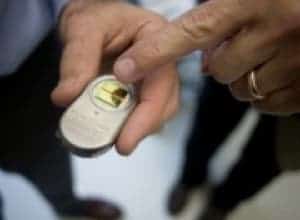The prospect of medical implants capable of delivering drugs directly to the patient’s blood stream or tissue has been an important subject for research. Recently, a microchip was implanted in 8 women, with the sole role of delivering an osteoporosis treating drug. The human trial is the culmination of 15 years worth of development work by MIT scientists.
Just 5 cm long and 3 cm wide, the microchip was implanted in less than 30 minutes, as the patients were under local anesthesia. The device has 20 tiny reservoirs, each holding 600-nanoliters of drug solution, at the bottom of which a thin layer of platinum or titanium was coated. When the payload had to be released, an electrical current passed through the reservoir, melting the bottom layer. This action could be programmed or triggered manually via a wireless command. Concerning treatment reports, the patients who had their drugs delivered via the implant fared just as well as those who had it injected. Due to its bidirectional nature, this allowed the researchers to both notice whether the device functioned properly or not, and monitor its performance.
The project was made possible thanks to the vision of Michael Cima and Robert Langer, both MIT scientists, who had worked on the microchip drug delivery solution for the past 15 years, and described it in a recent edition of the journal Science Translational Medicine.

The demand for an automated drug delivery solution has been at large for a while now, as it’s considered it can address a number of issues which inherently come along with traditional medical treatment. One big problem that interferes with a successful treatment is the patient himself. It’s imperetive for a patient to follow his prescribed drug treatment clockwise for the whole duration of it, otherwise, most often, the whole treatment will render poor results.
The tiny pharmacist
For this human trial, all of the implanted women suffered from osteoporosis. The drug treatment delivered through the microchip needs to be administered once a day for 20 days, hence the number of reservoirs in the device. Unfortunately, only one in four osteoporosis patients actually stick to their daily dose, the rest ending up ruining their treatment. Inevitably, more or less similar statistics in failure to stick to a treatment’s schedule has been reported for other diseases as well. The microchip drug delivery solution seeks to wipe this kind of problem all together. Also, it comes without the hassle of having to make regular hospital trips or face the needle on day-to-day basis.
“Compliance is very important in a lot of drug regimens, and it can be very difficult to get patients to accept a drug regimen where they have to give themselves injections,” says Cima, the David H. Koch Professor of Engineering at MIT. “This avoids the compliance issue completely, and points to a future where you have fully automated drug regimens.”
It might take a while before microchip implants will take off, though, as a lot more trials have to be completed and researchers need to ensure that the device is absolutely fail proof. Some concerns existed whether the microchip would be biocompatible or not, but luckily it performed magnificently in this respect. Still, the device is in its infancy and is a long way from proving it’s truly reliable, and to ensure this, a myriad of test runs have to be made. A glitch in the system might cause the entire drug payload, maybe worth a whole month’s treatment, to be released – this needs to be avoided at all costs. Also, what’s worse maybe, is having the device not do anything at all. If the microchip were to be employed to deliver drugs for diabetes patients, whose life depend on a regular and successful insulin injection, and it would stop working, then unexpected events of dramatic consequences might occur. Such a thing isn’t unthinkable, as for the current human test trial, out of the 8 individual implants, one didn’t work at all and was ruled out of the study. Hopefully, all of these issues, as well as all other foreseen by the researchers at the moment, will be resolved in the future.


